Pet Insurance Review > Pet Wellness Guides > 8 Tips for Camping with Your Dog - Pet Insurance Review
8 Tips for Camping with Your Dog
Posted: 09/14/2022 | BY: Erin Cain | Categories: Dog , Pet care , Top Tips
If you’re a dog owner, there’s a good chance that you enjoy spending time outdoors with your furry friend. And what better way to do that than take them on a camping adventure? Dogs can make great camping companions because they’re always up for a hike and love to explore new places. Camping with dogs can be an excellent experience for you and your pet, but pup parents must prepare it. Here are eight tips to help you have an enjoyable camping experience with your four-legged friend.
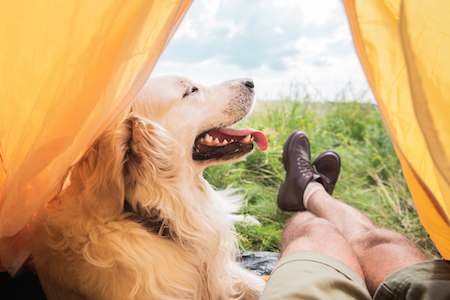
1. Research dog-friendly campsites
Camping is always more enjoyable with your furry friend by your side. However, you want to choose pet-friendly campgrounds for your camping adventure. Do your research and call ahead to campgrounds to find out if dogs are allowed and, if so, what the camp or park rules are regarding pets. Some sites may include extra costs for pet accommodation and may have certain restrictions or regulations that could apply to your dog while on campgrounds.
Campsite rules and regulations often note where a dog is or is not allowed to accompany her owner. Some locations don’t allow dogs on trails or in local parks. In contrast, others only permit dogs within specific areas of trails or boardwalks. If you’re looking to take your pup on an adventure this summer, make sure that the park or campsite allows it. Don’t get caught off guard when you get there, and learn that no pets are allowed.
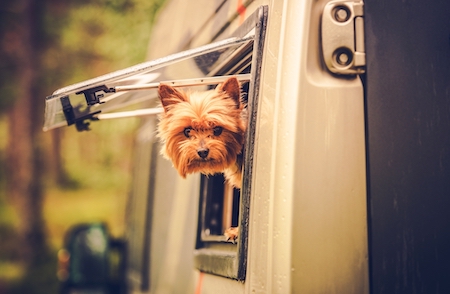
2. Update your pup’s vaccinations.
Make sure you take care of your dog’s health and vaccination requirements well in advance of your camping trip. Your dog needs to be up to date on all her shots, particularly her rabies vaccination. As many campgrounds require proof of a dog’s rabies vaccination before allowing the dog onto the property, it’s in your — and your dog’s — best interests to have that done and keep your paperwork in a safe place.
Ask your vet about vaccination for Lyme disease. This tick-borne illness can be transmitted through the bite of infected mosquitoes. Maintain proper flea control measures and heartworm prevention with monthly pills or topical applications so your dog doesn’t return from camping with a few tagalongs on and in her fur. Heartworm disease can become a life-threatening condition, and these parasites are found in all 50 states. Be sure that your dog is healthy and protected from anything she may encounter in the woods.
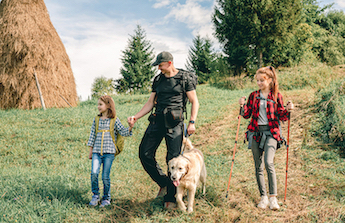
3. Always keep your dog secured.
Most campgrounds and parks require dogs to be on a leash. It would be best to double-check the leash laws in both the state you are traveling in and the campground where you are staying. Even if there are no definite leash rules, your dog could run into someone else’s campground and bother fellow campers. The pup might also get lost or go missing in a new environment or encounter a wild animal. It’s best to keep them on a short leash or set them up on a lead line or zipline provided it is secured to a strong ground stake.
You don’t want to take your dog on a camping trip without first training her to obey basic commands, such as stay and recall. If something happens and her leash breaks, you will need her to respond immediately to your call. There are many distractions out there — from other campers and their dogs to squirrels and other small animals — but you need your dog to focus solely on you should she somehow become loose. Keeping your dog with you will make for a safer and more enjoyable dog camping adventure.
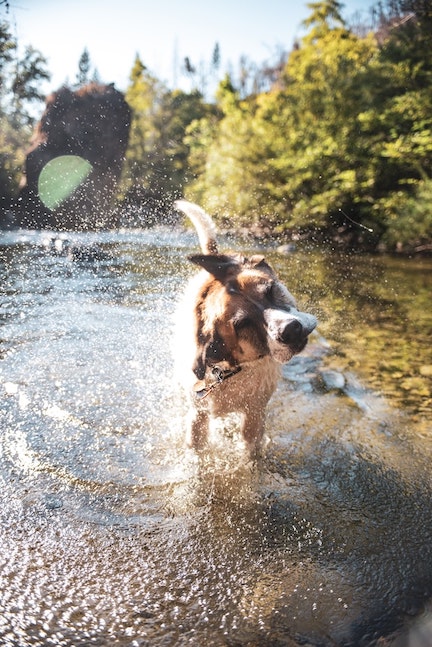
4. Bring plenty of water.
Check ahead of your trip to see if the campsite provides fresh, clean water access. If you don’t have access to drinkable water, bring more than enough water for both you and your dog. If you are camping in a warm, humid location, keep your dog hydrated. It doesn’t take much for a canine to suffer from heatstroke, which can be a life-threatening condition.
Prevent your dog from drinking from any standing bodies of water, as a stagnant pond or lake often carries bacteria that may be harmful if the dog ingests it. Make sure you have enough water for your dog. It’s a good idea to bring twice the average amount, just in case.
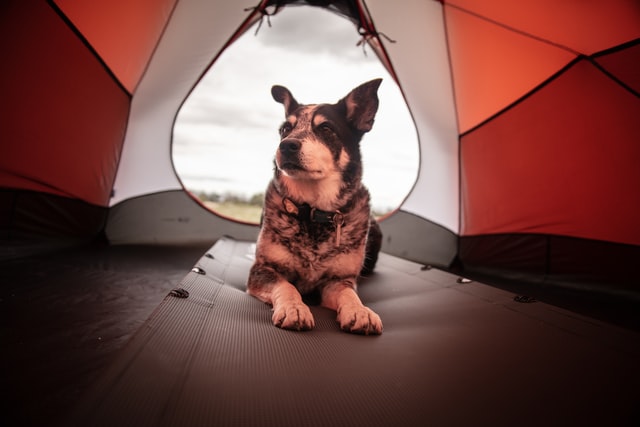
5. Choose the right size tent.
To keep your dog safe and secure at night, plan to have your dog sleep with you in your tent. That means it needs to be comfortably roomy enough for you, your dog, and anyone else who may be on the camping trip. Throw a sleeping bag or two in there, and it can get too cozy too quickly.
If you have a medium or large breed dog, it’s essential to find the right size shelter for her. Consider purchasing a spacious tent for your dog while factoring in the number of other people who will be there. What about your dog’s sleeping style? Is she a curl-up-and-sleep kind of canine, or does she spread out in strange contortions? Dogs sleep in various odd ways, so know the sleeping arrangements for the tent and consider your dog size and sleep style when you purchase a tent.
Many campsites require dogs to remain inside tents during the night to minimize contact with wildlife anyway, so having a comfortable shelter for you and your pup is a must. Remember to bring a sheet, blanket, or sleeping pad to lay down on the floor so that it protects the material from your dog’s claws. Tent camping with your dog can be fun, as long as you plan for it.
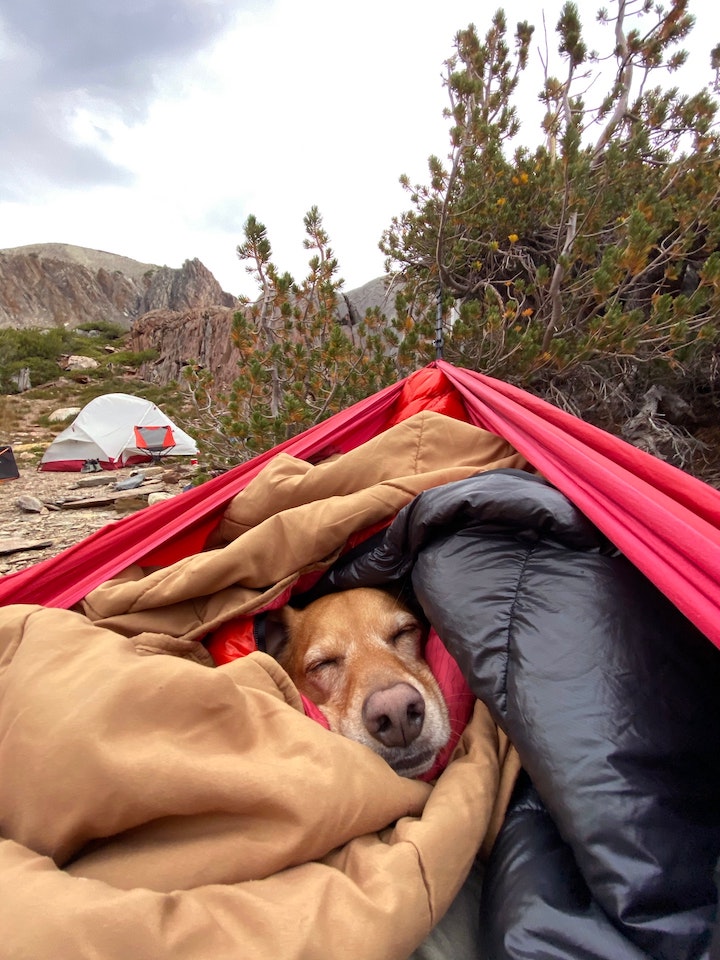
6. Prepare for emergencies.
You should make a laminated card with your dog’s identifying information, vaccination record, and health history, and keep it in a safe place during the camping trip. If your dog has a microchip (and she should), contact the company to verify the records associated with the chip. Update any new information, such as a change in address or contact methods, and don’t forget to do that for your dog’s tag on the dog’s collar. Should something happen and you are separated from your pup, the microchip and identification tag will be critical to reuniting with your dog.
A must for any trip with your dog is a first aid kit. Your kit should include all of their medical records and contact information, so they can receive treatment if needed while out on the road. Here are some other items to include in your pup’s emergency kit:
- a recent picture of your pet, in case they become lost
- an emergency fold-up blanket
- vet wrap or bandages
- flea and tick preventative
- tweezers or a tick removal device
- needle nose pliers
- absorbent and sterile gauze
- styptic powder
- paw balm (for protecting injured paws)
- saline wound flush (not hydrogen peroxide)
- wound disinfectant
- cotton balls and cotton-tipped swabs
- non-stick bandage pads
- blunt-tip scissors
- duct tape
- Benadryl for insect bites, stings, and allergic reactions
- alcohol wipes
- a small bandana that can cover as a tourniquet or muzzle
If you don’t have time to put a homemade first aid kit together, you can easily find a pre-made kit online or at your local pet store. It’s also helpful to plan and have the contact number and address of the nearest veterinary clinic should an emergency occur.
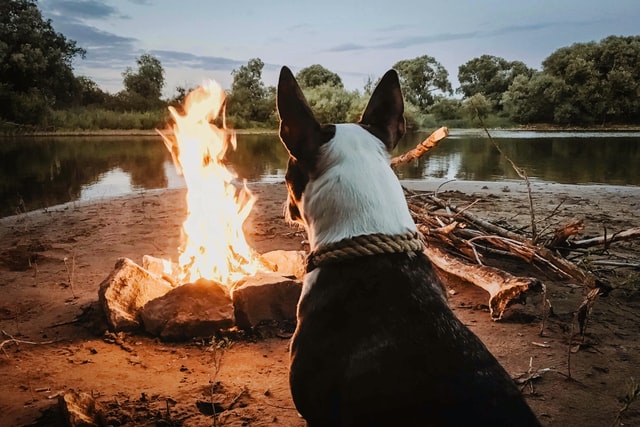
7. Please keep it clean.
To protect the wild places we all enjoy so much, every pet parent camper is responsible for leaving their camping location the way they found it: clean and undisturbed. That includes cleaning up after your canine companion during your camping trip.
Be a responsible pet owner and clean up after your dog. Bring plenty of dog waste bags to pick up after your pup. Just because you and your dog are in the woods doesn’t mean it’s okay to leave dog poop behind. Dog waste is a danger to the environment because it leads to soil and water contamination from bacteria and parasites and encourages the rapid growth and spread of noxious weeds.
The more people appreciate the outdoors with their four-legged friends, the more waste will be in our natural areas. It’s vitally important for our planet’s future to keep the environment as clean as possible, including our pups, too!

8. Make happy memories!
Camping with your pup is an experience like no other. You’ll get to spend quality time together and share new memories in the great outdoors while avoiding all those distractions from staying at home. You’ll spend quality time outside, explore new places, have fun, and make memories that will last forever. Happy tails!
Camping emergency? Pet insurance can help.
Emergencies can happen at any time, even on peaceful camping trips. Ensure that the best veterinarians can treat your dog’s injuries with top-notch medical equipment and treatment. Often, that level of care costs pet owners a significant amount of money; sadly, some owners have to choose between their dog’s care and their finances. You’ll no longer worry about being in that terrible situation with a pet insurance plan. Pet insurance is accepted nationwide by veterinary clinics, and it will reimburse you a large portion of emergency vet bills.
Go camping with your dog without the worry of what could go wrong. Protect your pet with a pet insurance plan today. Pet Insurance Review will do the hard work for you and find the best plans for your needs. Get your free pet insurance quote now!
References:
1. Carrick, E. (2020). The 10 Best Dog-friendly Campgrounds in the U.S. Retrieved from https://www.travelandleisure.com/trip-ideas/pet-friendly-travel/best-dog-friendly-campgrounds-in-us
2. Cain, E. (2022). How to Protect Your Dog from Lyme Disease. Retrieved from https://www.petinsurancereview.com/blog/how-protect-your-dog-lyme-disease
3. Madson, C. (2021). Reliable Recall: Teach Your Dog to Come When Called. Retrieved from https://www.preventivevet.com/dogs/how-to-teach-your-dog-to-come-when-called
4. Reisen, J. (2021). Heartworm in Dogs: What You Should Know About the Mosquito-Borne Parasite. Retrieved from https://www.akc.org/expert-advice/health/heartworm-in-dogs-symptoms-diagnosis-treatment/
5. Stregowski, J. (2021). How to Identify Heatstroke Symptoms in Dogs. Retrieved from https://www.thesprucepets.com/heat-stroke-in-dogs-1117860
6. Oakhurst Staff. (2021). Lakes, Ponds, and Water Safety for Dogs. Retrieved from https://www.oakhurstvet.com/blog/lakes-ponds-and-water-safety-for-dogs/
7. Marlowe Leverette, M. (2020). The best products for a pet emergency kit. Retrieved from https://www.insider.com/guides/pets/best-products-pet-emergency-kit
8. Baechler, N. (2018). Scoop the Poop: It’s Your Environmental Doody (pun intended). Retrieved from https://smea.uw.edu/currents/scoop-the-poop-its-your-environmental-doody-pun-intended/
DisclaimerThe information contained on this blog is intended for informational and educational purposes only and should not be construed as medical advice. It is not a substitute for professional veterinary care. Always consult with your veterinarian before making any changes to your pet's health care or treatment plan.
The authors of this blog are not veterinarians and do not claim to be experts in pet health. The information provided here is based on our own experiences and research, as well as information from reputable sources. However, we cannot guarantee the accuracy or completeness of this information.
We encourage you to do your own research and consult with your veterinarian before making any decisions about your pet's health.